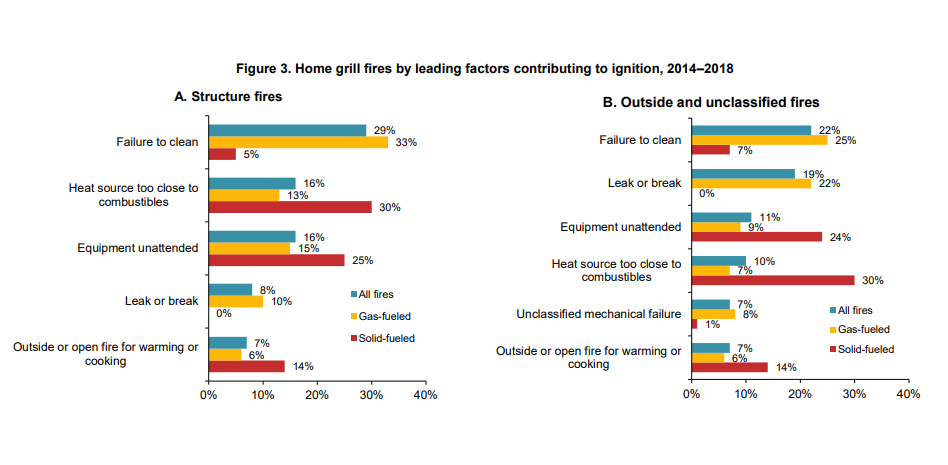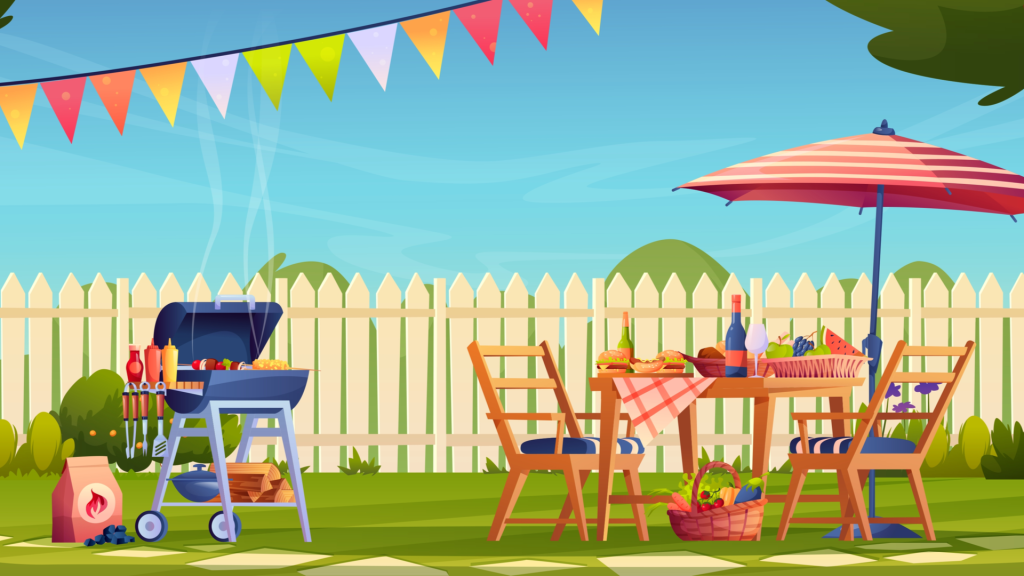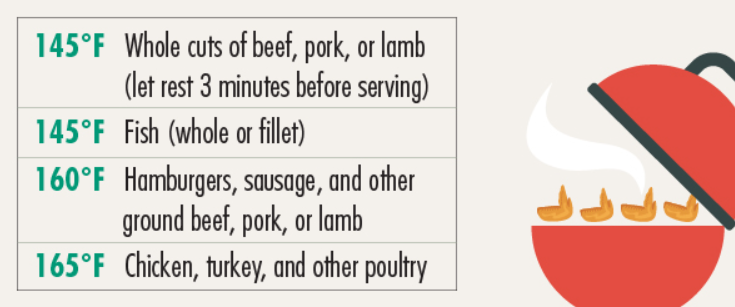Last Updated: July 8, 2022
Number of fires caused by grills
While grilling can be a fun summer activity, precautions must be taken to prevent bodily injury, as well as property damage and destruction. According to the National Fire Protection Association, an annual average of 10,600 home fires involving grills, hibachis, or barbecues resulted in nearly a dozen deaths, 160 injuries, and approximately $150 million in direct property damage. These statistics are due to a number of factors, including leaving the equipment unattended among others. (See Figure 1).
Figure 1. Home grill fires by leading factors contributing to ignition 2014-2018

Note. This graph was produced by M. Ahrens in 2020, depicting the common factors of fires.
The following preventative actions are recommended to decrease the risk of fires.
Grill Placement and Usage:
- Only use propane and charcoal grills outdoors and place the grill at least three feet away from the home, deck railings, and out from underneath leaves and overhanging branches.
- Keep children and pets at least three feet away from the grill.
- Pay particular attention to loose clothing and dangling jewelry which may present a hazard.
Propane Grills:
Check the gas tank hose for leaks before using it for the first time each year – you can do this by applying soap and water to the hose and checking for bubbles. If there are bubbles or a propane smell, and there is no flame, turn off both the gas tank and the grill. If the leak stops, get the grill serviced by a professional before using it again. If the leak does not stop or if you smell gas while cooking, do not attempt to move the grill, immediately move away from it, and call 911 (Ahrens, 2020).
If you find there are no gas leaks prior to lighting the grill, open the lid and check for any hidden nests, hives, or animals. It is good practice to thoroughly clean the grill to remove any excess grease before and after use. While cooking, remember to never leave the grill unattended. Once you are done, clean the grill each use to remove fat and grease that can start a fire (FEMA). Since propane gas is heavier than air, it will sink closer to the ground and can enter your home through doors, windows, and dryer vents. Never store the cylinder near these entry points. Also, make sure the propane tank is stored upright on a flat surface so that it can’t roll or tip over.
Charcoal Grills:
Only use a starter fluid designated for charcoal. Once you’re finished grilling, ensure that the charcoal and ashes are completely cooled by leaving the lid closed for 48 hours. For a faster process, douse the embers with water. After 48 hours, place the cooled ashes in a metal container or wrap them in foil before putting them in the garbage (Lam, 2020).
Food Safety in Grilling:
In addition to the dangers of suffering physical injury from improper outdoor cooking, the Centers for Disease Control & Prevention estimates there are approximately 48 million cases of food poisoning each year of which grilling plays a significant part. It is important to pay particular attention to the temperature of your food before, during, and after its preparation.
- Keep meat, poultry, and seafood refrigerated until ready to grill. When transporting, keep food below 40°F in an insulated cooler.
- Use a food thermometer to make sure meat is cooked hot enough to kill germs. (see Figure 2 for safe minimum internal temperatures).
- When using a BBQ smoker, monitor the air temperature within the smoker to be sure the heat stays between 225°F and 300°F throughout the cooking process. This will ensure the meat is fully cooked.
Figure 2. Correct temperature to grill different types of meat
Note. This graph was produced by the Centers for Disease Control and Prevention in 2020, to show the right temperature to cook meat to ensure food safety.
| 145°F | Whole cuts of beef, pork, or lamb (let rest 3 minutes before serving) |
| 145°F | Fish (whole or fillet) |
| 160°F | Hamburgers, sausage, and other ground beef, pork, or lamb |
| 165°F | Chicken, turkey, and other poultry |
References:
Ahrens, M. (2020, May). Home grill fires – NFPA. Retrieved July 7, 2022.
Centers for Disease Control and Prevention. Food Safety. Retrieved July 7, 2022.
FEMA. Grilling Fire Safety Flyer – U.S. Fire Administration. Retrieved July 7, 2022, from
Lam, D. (2021, July 2). Backyard grilling seems safe, until it isn’t. NPR. Retrieved July 7, 2022,


